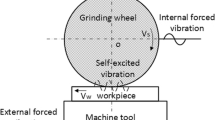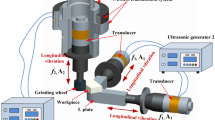Abstract
Based on the ultrasonic vibration technology and the electrochemical principle, the ultrasonic vibration-assisted electrolytic in-process dressing internal (UAEI) grinding is realized on the vertical machining center. The mathematical control model of the UAEI grinding is established to maintain the protrusion height of abrasive grains. Simulations and fittings show that the average current is positively associated with the increase of ultrasonic frequency, grinding speed or workpiece speed, and the decrease of grinding ratio. Concrete control schemes are made by adjusting the controllable parameters. The objective judgments are obtained by comparing the experimental results under different processing conditions. The experimental results show that the surface roughness of workpiece can research 0.0487 μm, the grinding force ratio maintains at relatively stable level, topography of oxide layer presents uniform-distributed cavities, and surface micro-topography of workpiece becomes smoother with the processing parameters determined by the control model of the UAEI grinding, proving the validity of this control model of the UAEI grinding.
Similar content being viewed by others
References
Bokhan YI, Bulavin VA, Klubovich VV, Sakevich VN, Trofimovich LI (1996) Mechanical properties of structural ceramics based on Al 2 O 3. Glass Ceram 53(7-8):240–242
Medvedovski E (2001) Wear-resistant engineering ceramics. Wear 249(9):821–828
Kapustina TP (1959) The grinding of ceramic materials with free abrasive. Glass Ceram 16(6):323–327
Kapustina TP, Bykova AA (1995) The grinding of ceramic material with bonded abrasive. Glass Ceram 16(7):371–375
Piskunov EG, Korolev DI (1993) Polishing of the working surfaces of ceramic parts. Refract Ind Ceram 34 (5):342–344
Ramesh K, Yeo SH, Gowri S, Zhou L (2001) Experimental Evaluation of Super High-Speed Grinding of Advanced Ceramics. Int J Adv Manuf Technol 17(2):87–92
Zaitsev GN, Nikitkov NV, Buturovich IK (1980) Effectiveness of surface ultrasonic grinding of ceramics with diamond disks. Glass Ceram 37(4):185–186
Azarhoushang B, Tawakoli T (2011) Development of a novel ultrasonic unit for grinding of ceramic matrix composites. Int J Adv Manuf Technol 57(9):945–955
Ding K, Fu Y, Su H, Xu H, Cui F, Li Q (2016) Experimental studies on matching performance of grinding and vibration parameters in ultrasonic assisted grinding of SiC ceramics. Int J Adv Manuf Technol doi:10.1007/s00170-016-8977-6
Yan YY, Zhao B, Liu JL (2009) Ultraprecision surface finishing of nano-ZrO 2 ceramics using two-dimensional ultrasonic assisted grinding. Int J Adv Manuf Technol 43(5):462–467
Wei S, Zhao H, Jing J, Liu Y (2015) Investigation on surface micro-crack evaluation of engineering ceramics by rotary ultrasonic grinding machining. Int J Adv Manuf Technol 81(1):483–492
Mamalis AG, Kundark J, Gyani K, Horvath M (2002) On the Precision Grinding of Advanced Ceramics. Int J Adv Manuf Technol 20(4):255–258
Kim JD, Lee ES (1996) A Study of Mirror-like Grinding of Fine Ceramics with In-process Electrolytic Dressing. Int J Adv Manuf Technol 12(4):246–254
Zhang C, Ohmori H, Marinescu I, Kato T (2001) Grinding of Ceramic Coatings with Cast Iron Bond Diamond Wheels. A Comparative Study: ELID and Rotary Dresser. Int J Adv Manuf Technol 18(8):545–552
Murali MS (2014) Hybrid machining processes. In: Nee AYC (ed) Handbook of manufacturing engineering and technology. Springer, London, pp 1–16
Lian HS, Guo ZN, Liu JW, Huang ZG, He JF (2016) Experimental study of electrophoretically assisted micro-ultrasonic machining. Int J Adv Manuf Technol 85(9):2215–2124
Dubey AK, Shan HS, Jian NK (2008) Analysis of surface roughness and out-of-roundness in the electro-chemical honing of internal cylinders. Int J Adv Manuf Technol 38(5):491–500
Lim HS, Fathima K, Kumar AS, Rahman M (2002) A fundamental study on the mechanism of electrolytic in-process dressing (ELID) grinding. Int J mach Tools Manuf 42(8):935–943
Yang L, Ren C, Jin X (2010) Experimental study of ELID grinding based on the active control of oxide layer. J Mater Process Technol 210(13):1748–1753
Guan JL, Guo DM, Yuan ZJ (2000) Research on the characteristic and roles of oxide film on grinding wheel of flid mirror surface. Chin J Mech Eng 36(5):89–92
Nadolny K (2015) Wear phenomena of grinding wheels with solCgel alumina abrasive grains and glassCceramic vitrified bond during internal cylindrical traverse grinding of 100Cr6 steel. Int J Adv Manuf Technol 77(1):83–98
Li BM, Zhao B (2003) Modern grinding technology. Mechanical Industry, Beijing
Zhang JH (2008) Predict one-way plane grinding hardening layer and research on friction and wear performance. Dissertation, Shandong University
Lawn B, Wilshaw R (1975) Indentation fracture: principles and applications. J Mater Sci 10(6):1049–1081
Shi XK, Teng L, LI YQ (1996) Critical conditions for brittleness-ductility transition of hard brittle materials. Aviat Precis Manuf Technol 32(4):10–13
George J, Peter G (1985) Microindentation analysis of di-ammonium hydrogen citrate single crystals 20(9):3150–3156
Yu XG (2004) Micro-fracture mechanism of nano-composite ZTA ceramic research. Dissertation, Shandong University
Sairam S, Clifton RJ (1994) Pressure-shear impact investigation of dynamic fragmentation and flow of ceramics. IEEE 21:217– 222
Marshall DB, Lawn BR, Evans AG (1982) Elastic/plastic indentation damage in ceramics: the lateral crack system 63(11):574– 581
Kwak JS, Ha MK (2002) Evaluation of wheel life by grinding ratio and static force. J Mech Sci Technol 16(9):1072–1077
Acknowledgments
The authors acknowledge the financial support from the National Natural Science Foundation of China (51175153 and 51475148). The authors also would like to thank the anonymous reviewers for the valuable comments and suggestions to improve the manuscript.
Author information
Authors and Affiliations
Corresponding author
Rights and permissions
About this article
Cite this article
Zhao, B., Jia, X., Chen, F. et al. Control model and the experimental study on the ultrasonic vibration-assisted electrolytic in-process dressing internal grinding. Int J Adv Manuf Technol 92, 1277–1289 (2017). https://doi.org/10.1007/s00170-017-0203-7
Received:
Accepted:
Published:
Issue Date:
DOI: https://doi.org/10.1007/s00170-017-0203-7




